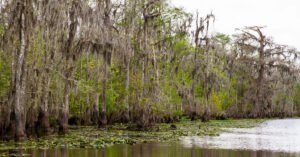Louisiana approves the 2025 Coastal Annual Plan

Every year, Louisiana’s Coastal Protection and Restoration Authority (CPRA) releases its Coastal Annual Plan for the upcoming fiscal year. This plan roadmaps how and where coastal funding will be used. After receiving approval from the state Legislature, the plan will go into effect at the beginning of the fiscal year. This year Louisiana showed its dedication to facing this coastal land loss problem head-on with the passage of a whopping $1.71 billion Coastal Annual Plan. The 2025 Annual Plan allocates funding for 136 active projects; these include 83 in construction, 45 in engineering and design and 8 in planning.
Why is Louisiana’s Coastal Annual Plan important to sportsmen?

Projects found within Louisiana’s Coastal Annual Plan are based on sustainable solutions to coastal land loss, including the restoration of wetlands, marsh creation projects, the protection of barrier islands, and the implementation of sediment diversions. This year alone, CPRA’s Annual Plan dictates $1.35 billion for project construction, benefiting approximately 167,481 acres of our beloved sportsman’s paradise. Let’s take a look at two projects included in this year’s iteration of the Annual Plan.
PROJECT HIGHLIGHTS
LaBranche East Marsh Creation – in construction; nestled along the south shore of Lake Pontchartrain, the LaBranch Wetlands stand as the largest continuous tract of wetlands in the area, sprawling across an impressive 20,000 acres of marsh and cypress swamp. The LaBranche East Marsh Creation project aims to convert degraded wetlands back into a thriving marsh and ecosystem. Once finished, this project will have created 1,471 acres of new emergent wetlands, enhancing waterfowl, fish and wildlife habitat in the surrounding area.
River Reintroduction into Maurepas Swamp – This diversion project will transport sediment and freshwater from the Mississippi River into the existing wetlands in East Maurepas Swamp. Historically, the Maurepas Swamp would receive a similar influx of sediment and freshwater during springtime flooding of the Mississippi River, but the construction of the Mississippi River levee system has cut off this life vein from a once pristine swamp forest. Not only does this project promise the longevity of the Maurepas Swamp, but it also has countless long-term benefits for sportsmen, including rehabilitating this once-productive waterfowl habitat with nutrient-rich sediment to promote subaquatic vegetative growth, revitalizing the old-growth swamp forest which is crucial habitat for whitetail deer, and improving water quality and habitat for many of our freshwater game fish species including bass and sacalait.
Our marshes, swamps and estuaries provide crucial habitat for a wide variety of fish and wildlife species. Protecting, restoring and enhancing these habitats are crucial in maintaining our abundant populations of game fish and yearly flights of migratory waterfowl. Ensuring that our sportsman’s paradise can continue to thrive and attract millions of outdoor enthusiasts to coastal Louisiana is of utmost importance. It’s paramount that sportsmen continue to support our state’s coastal programs as they work to restore and protect these delicate habitats, ensuring that they will be there for future generations to enjoy.
